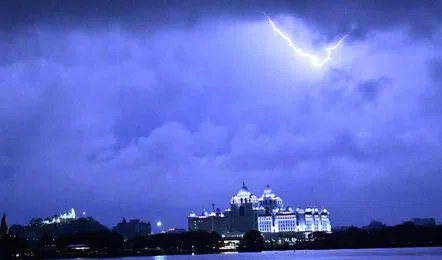Telangana — and particularly Hyderabad — is currently under heightened vigilance due to intense monsoon activity. With IMD’s recent orange and yellow alerts, residents and authorities alike are preparing for widespread heavy rainfall, thunderstorms, and flash flooding. This extensive coverage will help you understand the what, why, and how — ensuring you’re informed, safe, and ahead of the storm.
Rain Alert in Telangana and Hyderabad: IMD Issues Heavy Rainfall Warning | Full District-wise Forecast and Safety Guide
1. Latest Rain Alerts: What You Need to Know
1.1 IMD Alerts and Affected Districts
- Orange Alert (Heavy to very heavy rain, 115–204 mm): includes Adilabad, Kumuram Bheem Asifabad, Mancherial, Peddapalli, Jayashankar Bhupalpally, Mulugu, Bhadradri Kothagudem, Khammam, Mahabubabad, Warangal, Hanamkonda, Karimnagar, Nizamabad, Jagtial, Siddipet, Kamareddy, Nagarkurnool, and Hyderabad (X (formerly Twitter).
- Yellow Alert (moderate to heavy rain, 64–115 mm): applies to Khammam, Nalgonda, Medchal‑Malkajgiri, Rangareddy, Vikarabad, Sangareddy, Medak, Mahabubnagar, Nagarkurnool, Yadadri‑Bhuvanagiri, Suryapet, and Hyderabad.
- Thunderstorms, lightning & gusty winds expected across all 33 districts.
1.2 IMD District‑wise Warnings
According to IMD’s district‑level forecasts (issued on July 22):
- July 22: Extremely heavy rain, thunderstorms & squall
- July 23: Very heavy rain, thunderstorms & lightning
- July 24–25: Heavy rain, thunderstorms
- July 26: Thunderstorms & lightning
- July 27–28: No warnings (India Meteorological Department).
2. Why This Rain, Why Now? — Meteorological Drivers
2.1 Monsoon Dynamics
- A deep monsoon trough extends from Punjab across central India to the Bay of Bengal.
- An upper-air cyclonic circulation over north coastal Andhra, and a shear zone near 13° N, intensify rainfall.
2.2 Low‑Pressure Area
- IMD forecasts formation of a low‑pressure area around July 24, amplifying Telangana’s rain prospects in the days following July 22.
3. Hyderabad Under Storm: Impact & Local Alerts
3.1 Record Showers & Disruption
- On July 19, parts of Hyderabad recorded 100+ mm in 24 hours—triggering traffic jams, power outages, and major waterlogging.
- Monday’s rain brought 65 mm in Rajendranagar, 26 mm in Bahadurpura, and 18 mm in Bandlaguda.
3.2 Vulnerable Zones & City Infrastructure
- Low‑lying areas—Pillar 191 near Aramghar, Whitehouse‑Pallecheruvu, Durganagar, Zoo Park, underpasses—flood easily.
- GHMC deployed water pumps and emergency teams; authorities flagged six key zones (Khairatabad, LB Nagar, Charminar, Secunderabad, Kukatpally, Serilingampally) as high‑impact.
4. Government & Agency Response
4.1 Political Leadership
- CM Revanth Reddy convened multiple reviews:
- July 21: Instructed district collectors to coordinate 24/7, ready GHMC, SDRF, HYDRAA and medical teams.
- June 3: Focus on drainage, pumps, summit at Musi, Mir Alam Tank rejuvenation—coordinated by GHMC, HYDRAA, HMDA, traffic authorities.
4.2 Disaster Management Mechanisms
- HYDRAA (since July 2024) coordinates disaster response, asset protection, and supports DRF operations in Greater Hyderabad.
- GHMC has installed rain‑water sumps and portable pumps in critical flood zones.
- Emergency teams on standby: GHMC, police, SDRF, HYDRAA, and rural medical units.
5. Historical Context: Monsoon Lessons
5.1 2020 Flash Floods
Hyderabad experienced devastating flash floods in October 2020 (Deep Depression BOB 02), with ~32 cm rainfall, 100+ deaths, and ₹1,230 crore losses .
5.2 The 1908 Musi Deluge
The Great Musi Flood (September 1908) killed over 15,000 and prompted the construction of Osman and Himayat Sagar reservoirs—a critical early flood‑control measure.
6. On‑Ground Precautions & Advice
6.1 What Residents Should Do
- Monitor local IMD and Authority updates; heed orange/yellow alerts.
- Avoid travel during heavy downpours, especially through low‑lying zones.
- Keep first‑aid, torch, power-bank ready; avoid open wiring.
6.2 If You’re on the Move
- Drive slowly through waterlogged streets—do not attempt deep flooding.
- Turn off vehicles prone to engine stall.
- Use masks/filters if traveling in polluted, humid air.
6.3 Safety & Health
- Ensure roof and drainage cleanliness.
- Wash hands regularly to prevent water-borne diseases.
- Report power lines, broken poles, or outages immediately.
6.4 For Farmers & Rural Areas
- IMD advises 3‑hour advance warnings to villages.
- Protect monsoon crops; secure equipment and livestock.
7. Environmental & Infrastructure Challenges
7.1 Drainage Constraints
- Blocked drains and encroached canals worsen flooding. HYDRAA’s asset-protection role is critical.
- Persistent waterlogging points highlight need for overhaul.
7.2 Infrastructure Gaps
- Underpasses, old flyovers, and roads often lack systematic elevation planning.
- Need for robust real-time water monitoring systems.
8. What’s Ahead? Mid‑to‑Late Monsoon Outlook
- Heavy rains expected until July 25–26, gradually tapering thereafter.
- Low‑pressure development on July 24 could lead to renewed heavy spells.
- By July 27, IMD forecasts reduced rainfall—windy and storm‑free conditions.
9. Long‑Term Solutions & Upgrades
9.1 Catchment & Storage
- Reviving natural lakes and building reservoirs akin to early 20th‑century models.
- Example: Osman Sagar & Himayat Sagar still alleviate flood risk.
9.2 Stormwater Systems
- Smart drainage with water sensors, pump stations, and desilting ahead of peak monsoon.
9.3 Sustainable Urban Planning
- Regulate construction—prevent encroachments that stymie natural water flow.
- Enforce green buffer zones and permeable pavements to absorb rainwater.
10. Key Takeaways & Community Role
- Stay Informed – Keep up with alerts from IMD and GHMC.
- Stay Safe – Evade travel in high‑risk deep water zones.
- Stay Prepared – Basic kit, structural checks, and family planning.
- Stay Involved – Report issues, volunteer in local sanitation and drainage drives.
Telangana’s current rain alerts demonstrate the power—and unpredictability—of the monsoon. While nature is relentless, hybrid efforts from authorities, communities, and individuals can greatly reduce risks. With informed vigilance, rapid response systems like HYDRAA, and robust infrastructure, Hyderabad and surrounding districts can navigate the stormiest days of July 2025.
Let this be a season not just of survival, but of awakening—an opportunity to enhance city resilience and harmonize with monsoon rhythms.
Hyderabad to Yadadri MMTS Project: A Game-Changer in Telangana’s Transit Future
Last Updated on July 22, 2025 4:21 pm by Admin




